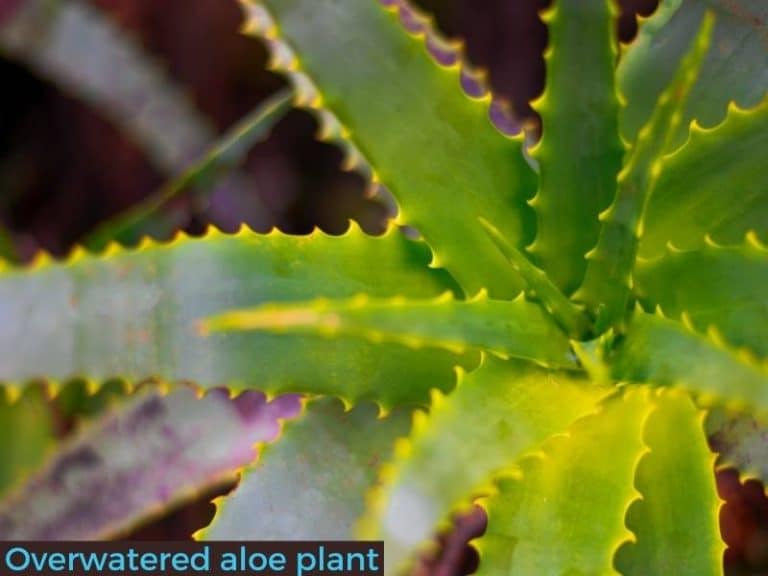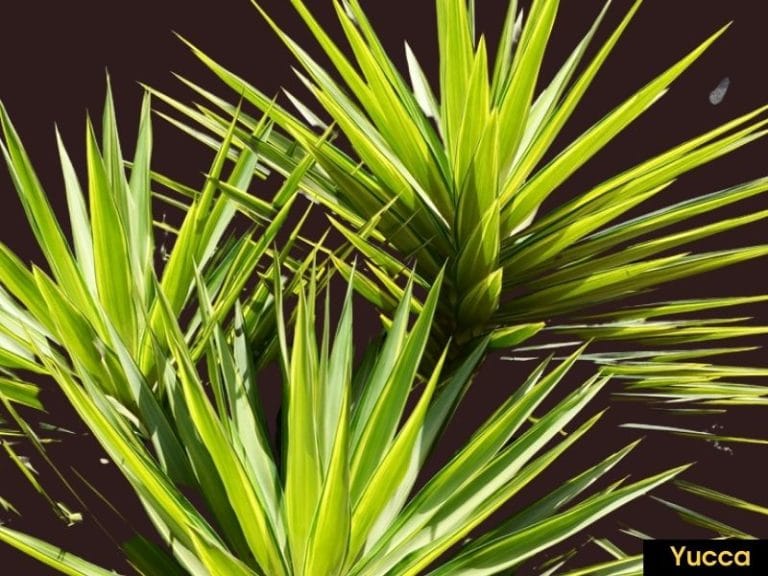Aloe Plant Turning Yellow and Pale – Causes + Fixes
Healthy aloe vera plants should look blue-green or grey-green, but when they start turning yellow, it means something is wrong. Usually, the problem is watering or nutrient deficiencies, but there are many other factors that can cause leaf discoloration. So, what causes aloe leaves to turn yellow?
Why is my aloe vera plant turning yellow?
With water, sunlight, and well-draining soil, aloe plants can grow young green leaves. When grown in unfavorable conditions, leaves and stems can turn pale yellow and progress gradually to turn light brown due to many factors.
Here are the 7 causes of yellowing in aloe vera:
1. Overwatering
Too much water quickly suffocates the roots of your aloe vera plant making it difficult to absorb water, nutrients, and oxygen. If your aloe vera plant has been sitting in a waterlogged pot for a couple of days or weeks, it will start turning yellow and soft.
The aloe plant has a few stomata, which is necessary for quick perspiration. Too much water accumulates in the leaf pulp, which can damage the structure of its tissues. It also causes rotting in its roots, which is manifested in the yellowing of the leaves from the base and upwards along the blade. In addition, the leaves become soft and may even start to look translucent.
Finding out if your plant is overwatered is easy. Scoop a little soil from the pot to see if it is waterlogged. If it is a potted aloe plant, try lifting it to measure its weight. If it feels heavier than usual, it probably is saturated with water, which is the main reason for the plant’s leaves turning yellow.
2. Potting shock
While an aloe vera plant may be hardy and adaptable, too much stress can lead to yellowing in its leaves. For example, if you moved it outdoors after growing it indoors for quite a while, the harsh sunlight may burn the tips of its leaves. A plant can only adapt to a change of environment when the change is gradual. That way, it develops sun-blocking mechanisms, preventing its leaves from succumbing to burns.
If your aloe plant is showing signs of leaf discoloration just after repotting or moving it outdoors, it is highly likely the problem is repotting shock. You might want to let it sit outside for just a few hours each day, gradually increasing the time until it adapts to that change of environment.
3. Underwatering
Aloe vera plants can tolerate drought and still thrive well between two and three months without water. However, underwatering or no watering at all will stress it out and cause leaf discoloration.
Leaves will start turning pale yellow and progress to brown tips if the problem is insufficient watering. Other signs of underwatering in aloe plants include:
- Wrinkly leaves
- Floppy, droopy leaves
- Drying edges
If you notice leaf discoloration that’s accompanied by unhealthy, shriveled leaves, provide the plant with water but be careful not to overwater the succulent.
4. Insufficient light
Aloe plants (like any other green plants) rely on their green-coloring matter to change light energy into chemical energy. When the sun is at its highest during the summer season, you may notice your aloe vera leaves turning yellow to light brown due to burns.
During winter, aloe vera hibernates, losing more water than it should. This may cause it to turn yellow. To ensure it retains its green color, ensure you place it in an area with sufficient light like the balcony or near windows.
5. Nutrient deficiency
Aloe plants thrive and survive in nutrient-poor soils in their natural habitats. However, nutrient deficiency can lead to unusual signs that easily manifest in stunted growth, unhealthy appearance, and susceptibility to diseases.
If the succulent is turning yellow even when watered properly and growing under sufficient light, the reason may be iron deficiency or general lack of nutrition.
Apply fertilizer to help the plant recover from the yellowing. Take note that if the plant didn’t receive sufficient water before fertilizer, it might also be suffering from fertilizer burns. If you applied the fertilizer during winter when it is hibernating, chances are it could turn yellow.
6. Diseases
Aloe vera and similar plants are highly resistant to diseases and even pests but they can still suffer from some problems such as root rot, fungal stem rot, soft rot, leaf rust, and leaf rot. All of these diseases quickly manifest in the leaves of the plant, with some of them showing signs such as:
- Leaves turning yellow
- Brown spots on the leaves
- Slowed growth
- Soft and mushy leaves, etc
As the diseases progress rapidly, you might notice tips of the leaves drying out instead of being well developed.
7. Fertilizer burn
Yellowing aloe leaves are probably a sign of fertilizer burn, which occurs if you apply too much synthetic fertilizer. The salts accumulate in the soil, causing plant stress. The signs manifest as leaves changing their color, reduced growth, and general ill-health.
If the yellowing occurred a few days after applying fertilizer to the pot, you want to wash away the excess salts from the potting mix to help the succulent recover quickly.
How to fix a yellow aloe plant
A yellow aloe plant is a symptom of many factors, including overwatering, underwatering, diseases, insufficient light, unsuitable nourishment supplements, and growing conditions. The best way to revive your aloe vera and turn leaves green again is to determine the cause first, then fix it with the right measures.
Here’s how to fix a yellow aloe plant:
1. Dry out overwatered soil
If the pot feels unusually heavy and saturated with excess water, allow the soil to halfway before watering again. Alternatively, replace the waterlogged soil with dry soil if waiting for the pot to naturally drain is not a great option for you.
Remove the plant from the pot and place it in a shaded area. Pour the soil onto old newspapers to drain the excess water. Repot the aloe vera plant using the drained soil or a new potting mix. Place it in a shaded area and water lightly until it recovers from the yellowing.
2. Water the aloe plant once per week
Get a pot with holes to allow excess water to drain out more frequently to prevent leaves from turning yellow.
Aloe vera plants prefer to be watered only when the top half of the soil dries out. Since the plant can survive drought and remain healthy, let it sit until when the soil is dry before watering. This will prevent root rot, yellowing, browning, and other problems.
3. Provide bright indirect light
Aloe plants can tolerate direct sunlight for a limited number of hours. If the leaves are turning pale yellow due to insufficient light, provide a minimum of six hours of direct sunlight per day – preferably during the morning hours. Alternatively, provide bright indirect sunlight all day long.
You can place the aloe plant in a room with sufficient light or outdoors for at least 6 hours. When aloe doesn’t receive enough light, it will turn light green, then gradually to yellow. The plant also feels softer. If your house or apartment isn’t well-lit, move the pot outside for at least 12 hours a day. During summer, provide it with some shade.
4. Apply fertilizer less frequently (twice a year)
When wrongly fertilized, aloe may turn yellow evenly and become soft. In that case, it would be imperative to change the soil and avoid applying fertilizers until the plant recovers from the excess salt stress.
Use an organic fertilizer or even a synthetic one sparingly to give the plant just enough nutrients without stressing it.
Keep in mind that it is important to water the succulent to keep the soil moist especially after fertilizing it. This prevents fertilizer burn and also provides a medium for the fertilizer to dissolve in and become accessible to the plant’s roots.
5. Treat diseases and pests
An aloe may turn from yellow to brown depending on the severity of the disease. Most of the time, the yellow leaves are a sign of root rot, which also manifests as mushy, rotting roots.
Remove the aloe plant from its pot and inspect the roots. If some are turning black and mushy, cut them away and treat the remaining ones with a weak hydrogen peroxide solution. Repot the plant and observe it till it revives from the yellowing.
If you’re not sure what disease the aloe plant is suffering from, call a gardening expert to diagnose the disease and tailor a suitable treatment plan to save your plant.
On the other hand, a pest infestation can also compromise the growth of an aloe plant. Pests known for attacking aloe include aphids, scale insects, mealybugs, and others. They feed on the leaves and suck the sap, causing it to turn yellow.
Seeking pest extermination and disease control services can be the only way to make it green and healthy again.
6.Use a small-sized pot for easy acclimatization
It’s normal to feel overly generous with the size of your pot when transplanting your house plant. Nevertheless, an aloe plant doesn’t need a large pot because its root system cannot take up all the water. That may result in oversaturation for an extended time.
Instead of going for large-sized pots, get one with a dense root mass so that by the time you are transplanting them, you can move them to the ideal-sized pot. It’s safer to get one with space all around its sides.
Can a yellow aloe plant turn green again?
A yellowing aloe vera plant can turn green again if the problem is insufficient light or too much salts in the soil. Minimal leaf discoloration can be reversed with proper watering and providing bright indirect light. However, if the damage is too extensive, it might not be possible to make the leaves green.
With extensive yellowing, you’ll want to cut away the aloe vera leaves to save the plant especially if the root problem is a severe fungal infection.
It is common for autumn trees to have yellow leaves due to insufficient water and other factors, but not for indoor plants like aloe vera. An unhealthy aloe that’s yellowing is a symptom of a plant in distress. Fortunately, there are many things you can do to restore its health, but only if you take action early enough.
The growing conditions also need to be improved. For most gardeners with such a problem, overwatering is the likely cause. We all assume that all plants need sufficient water when it’s hot, but this can be disastrous for aloe vera. In reality, an aloe that is sick due to overwatering may be daunting to save. Like any other succulent, aloe plant can turn green again if the source of stress is removed. If it turns brown, there is no turning back.
While an aloe plant is easy to maintain, subjecting it to the wrong growing conditions can affect its health. If you notice that it turns yellow, find out what the cause is and fix it immediately. Otherwise, browning aloe vera is a sign of long-term neglect that may not be reversed.
References
- Pennstate Univeesity Plant Village: Aloe Vera Diseases and Pests
- Sandra Mason, University Of Illinois Extension: Yellow Leaves Can Indicate Plant Problems




